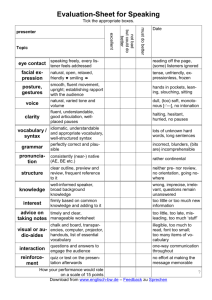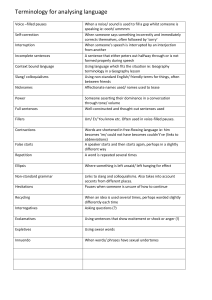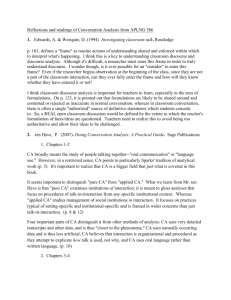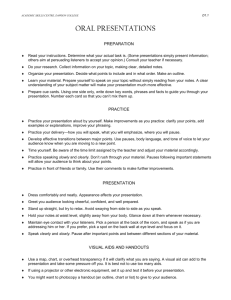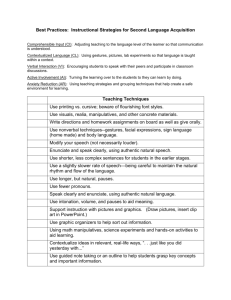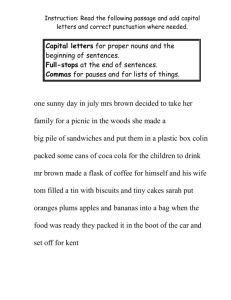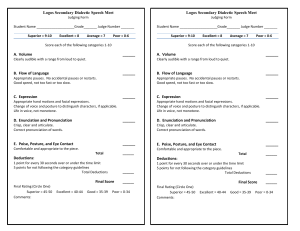3. Occurrence analysis of silent pauses
advertisement
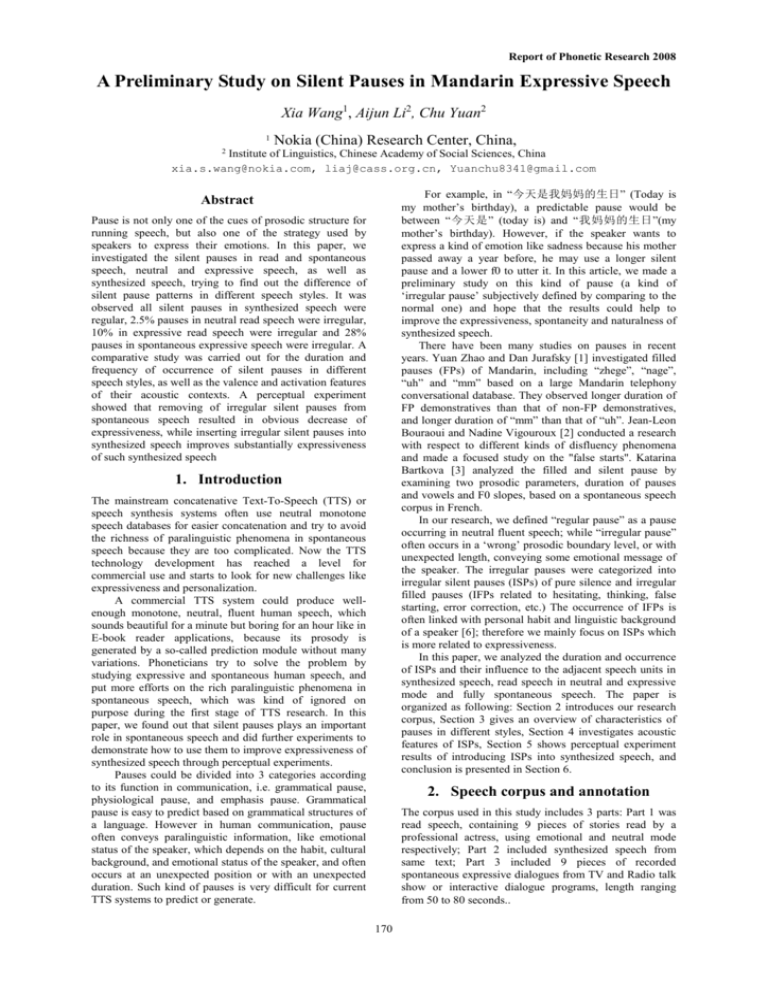
Report of Phonetic Research 2008 A Preliminary Study on Silent Pauses in Mandarin Expressive Speech Xia Wang1, Aijun Li2, Chu Yuan2 1 Nokia (China) Research Center, China, 2 Institute of Linguistics, Chinese Academy of Social Sciences, China xia.s.wang@nokia.com, liaj@cass.org.cn, Yuanchu8341@gmail.com For example, in “今天是我妈妈的生日” (Today is my mother’s birthday), a predictable pause would be between “今天是” (today is) and “我妈妈的生日”(my mother’s birthday). However, if the speaker wants to express a kind of emotion like sadness because his mother passed away a year before, he may use a longer silent pause and a lower f0 to utter it. In this article, we made a preliminary study on this kind of pause (a kind of ‘irregular pause’ subjectively defined by comparing to the normal one) and hope that the results could help to improve the expressiveness, spontaneity and naturalness of synthesized speech. There have been many studies on pauses in recent years. Yuan Zhao and Dan Jurafsky [1] investigated filled pauses (FPs) of Mandarin, including “zhege”, “nage”, “uh” and “mm” based on a large Mandarin telephony conversational database. They observed longer duration of FP demonstratives than that of non-FP demonstratives, and longer duration of “mm” than that of “uh”. Jean-Leon Bouraoui and Nadine Vigouroux [2] conducted a research with respect to different kinds of disfluency phenomena and made a focused study on the "false starts". Katarina Bartkova [3] analyzed the filled and silent pause by examining two prosodic parameters, duration of pauses and vowels and F0 slopes, based on a spontaneous speech corpus in French. In our research, we defined “regular pause” as a pause occurring in neutral fluent speech; while “irregular pause” often occurs in a ‘wrong’ prosodic boundary level, or with unexpected length, conveying some emotional message of the speaker. The irregular pauses were categorized into irregular silent pauses (ISPs) of pure silence and irregular filled pauses (IFPs related to hesitating, thinking, false starting, error correction, etc.) The occurrence of IFPs is often linked with personal habit and linguistic background of a speaker [6]; therefore we mainly focus on ISPs which is more related to expressiveness. In this paper, we analyzed the duration and occurrence of ISPs and their influence to the adjacent speech units in synthesized speech, read speech in neutral and expressive mode and fully spontaneous speech. The paper is organized as following: Section 2 introduces our research corpus, Section 3 gives an overview of characteristics of pauses in different styles, Section 4 investigates acoustic features of ISPs, Section 5 shows perceptual experiment results of introducing ISPs into synthesized speech, and conclusion is presented in Section 6. Abstract Pause is not only one of the cues of prosodic structure for running speech, but also one of the strategy used by speakers to express their emotions. In this paper, we investigated the silent pauses in read and spontaneous speech, neutral and expressive speech, as well as synthesized speech, trying to find out the difference of silent pause patterns in different speech styles. It was observed all silent pauses in synthesized speech were regular, 2.5% pauses in neutral read speech were irregular, 10% in expressive read speech were irregular and 28% pauses in spontaneous expressive speech were irregular. A comparative study was carried out for the duration and frequency of occurrence of silent pauses in different speech styles, as well as the valence and activation features of their acoustic contexts. A perceptual experiment showed that removing of irregular silent pauses from spontaneous speech resulted in obvious decrease of expressiveness, while inserting irregular silent pauses into synthesized speech improves substantially expressiveness of such synthesized speech 1. Introduction The mainstream concatenative Text-To-Speech (TTS) or speech synthesis systems often use neutral monotone speech databases for easier concatenation and try to avoid the richness of paralinguistic phenomena in spontaneous speech because they are too complicated. Now the TTS technology development has reached a level for commercial use and starts to look for new challenges like expressiveness and personalization. A commercial TTS system could produce wellenough monotone, neutral, fluent human speech, which sounds beautiful for a minute but boring for an hour like in E-book reader applications, because its prosody is generated by a so-called prediction module without many variations. Phoneticians try to solve the problem by studying expressive and spontaneous human speech, and put more efforts on the rich paralinguistic phenomena in spontaneous speech, which was kind of ignored on purpose during the first stage of TTS research. In this paper, we found out that silent pauses plays an important role in spontaneous speech and did further experiments to demonstrate how to use them to improve expressiveness of synthesized speech through perceptual experiments. Pauses could be divided into 3 categories according to its function in communication, i.e. grammatical pause, physiological pause, and emphasis pause. Grammatical pause is easy to predict based on grammatical structures of a language. However in human communication, pause often conveys paralinguistic information, like emotional status of the speaker, which depends on the habit, cultural background, and emotional status of the speaker, and often occurs at an unexpected position or with an unexpected duration. Such kind of pauses is very difficult for current TTS systems to predict or generate. 2. Speech corpus and annotation The corpus used in this study includes 3 parts: Part 1 was read speech, containing 9 pieces of stories read by a professional actress, using emotional and neutral mode respectively; Part 2 included synthesized speech from same text; Part 3 included 9 pieces of recorded spontaneous expressive dialogues from TV and Radio talk show or interactive dialogue programs, length ranging from 50 to 80 seconds.. 170 Report of Phonetic Research 2008 Manual annotation was done using SAMPA-C [4] and C-ToBI [5] for segmental and prosodic features for all speech data. Additionally, two expressiveness parameters, namely valence and activation, were also manually labeled, to indicate whether an emotion is positive or negative, and the energy level of such emotion. The activation and valence of an irregular pause here refer to the activation and valence of the adjacent intonational phrase(s). Valence is categorized into three levels: positive (1), neutral (0) and negative (-1). Activation has three categories as well: excited (1), steady (0) and low (-1). When both of the emotional valence and activation of a certain irregular pause are marked as 0, the irregular pause is considered to be a neutral physiological state that does not carry any expressive information. A labeling example is shown in Figure 1. Among all the pauses (both regular and irregular), there were 2.5% irregular silent pauses in neutral read speech, 10% in expressive read speech and 28% in spontaneous expressive speech, which is substantially higher than the other styles, indicating an obvious differentiation of spontaneous expressive speech. Table 1: Silent pauses in different speech styles Type # regular # irregular Percentage of ISP pause pause PTTS 318 0 0 PTXT 311 0 0 PNTL 317 8 2.5% PEXP 316 35 10.0% PSPN 201 78 28.0% We also found out that when a speaker had a strong emotion towards the topic s/he was talking about (too excited, too sad, too nervous), or when s/he made mistakes, irregular silent pauses may occur inside a prosodic word. Otherwise, irregular pauses would still occur at potential prosodic boundaries( with unexpected level), but with patterns and acoustic contexts deviated from regular pauses as to be shown in the next section through detailed analysis of the database. 4. Acoustic analysis of irregular silent pauses Figure 1: Annotation Example 4.1. Duration analysis of irregular pauses Totally there are ten tiers of annotation in the above example. The 1st tier is the transcription of Chinese characters. The 2nd and 3rd tiers are syllables and initials/finals labeled by Chinese pinyin respectively. The 4th tier is the miscellaneous tier for paralinguistic and non-linguistic phenomena. The 5th tier is the turn-taking tier. The 6th tier is the prosodic boundary. The 7th tier is the stress tier. The 8th and 9th tiers are valence and activity states surrounding the silent pause. The last tier is for the irregular silent pauses labeled by “&”. One-way ANOVA analysis was made for duration of the irregular silent pauses in all speech data, using SPSS. Because there might be ISPs occurred one after another, the number of ISPs may vary from experiment to experiment in this section. Results showed that both valence and activation had significant influence on the duration of the ISPs (F(2,109)=0.037<0.05, F(2,109)=0.02<0.05 respectively). Table 2: ISP average duration in different valences DURA TION a,b S tuden t-Ne wm an-Keul s S u bse t for alp ha = .05 1 .36 89 .37 75 .62 77 .09 3 3. Occurrence analysis of silent pauses VA LENCE 1 0 -1 S ig . In this section, we analyzed the silent pauses in 5 styles of written or spoken materials. Four of them shared the same text material of a children’s story, including synthesized speech produced by a commercial Mandarin TTS system, pause annotation by 8 transcribers for possible pauses on the text file (no speech), and read speech by an actress in neutral mode and expressive mode respectively. In addition, pure spontaneous speech from TV and Radio talk show programs was also analyzed for comparison purposes. Table 1 gives a summary of silent pauses found in the 5 different types of materials. The meaning of the tokens are: PTTS for pauses in synthesized speech; PTXT for pauses marked in texts by eight transcribers; PNTL and PEXP for pauses in neutral read speech and expressive read speech respectively, and PSPN for pauses in spontaneous expressive speech recorded from TV or Radio programs. The materials based on the same text had similar number of regular pauses, which is inline with our definition of “regular pause”. PTTS and PTXT did not have any irregular silent pauses, which was also reasonable according to our definition. Not surprisingly, 90% of regular pauses in PTTS and PTXT share the same position, and most regular pauses in PTTS, PTXT and PNTL occur at prosodic boundaries. N 21 49 42 Me ans for grou ps i n ho mog ene ous sub sets are disp laye d. a. Us es Harm onic Me an S amp le S ize = 32 .667 . b. Th e gr oup size s ar e un equ al. T he h arm onic me an of th e gr oup size s is use d. T ype I err or levels are not g uar ante ed. Table 3: ISP average duration in different activations DURA TION a,b St udent-Ne wman-Keuls ACTIV ITY 1 0 -1 Sig. N 26 56 30 Subset for alpha = .05 1 2 .3026 .4033 .7385 .395 1.0 00 Me ans for groups in homoge neo us subse ts are displayed. a. Uses Harmo nic Mean Sample Size = 33.4 63. b. The group sizes are une qual. The harmo nic me an o f the group sizes is used. Type I e rror levels are not guarantee d. We also computed the mean duration under different valences and activations (or activities). The results are illustrated in table 2 and table 3, which indicates that the duration of ISPs is obviously longer when valence or activation is -1, from the other two valence or activation states.. In tables 2 and 3, N means number of ISPs. The average length of ISPs for 3 valence/activation states was counted in seconds. 4.2. F0 analysis of ISP acoustic contexts In this experiment, the highest and lowest F0 values of the preceding and following syllables of every ISP in all 171 Report of Phonetic Research 2008 speech data were analyzed. PSf0H, PSf0L, ASf0H and ASF0L stand for the highest F0 of the syllable preceding the ISP, the lowest F0 of the syllable preceding the ISP, the highest F0 of the syllable following the ISP and the lowest F0 of the syllable following the ISP. The values of f0H and f0L of an ISP are defined by comparing f0 values proceeding and following the ISP, as shown in table 4. contrary, when activity is 1 or 0, both the ASf0H and ASf0L are higher than PSf0H and PSf0L. Table 7: ANOVA analysis on f0 parameters by 3 valence states. ANOVA PS f0H Table 4: Definition of f0H and f0L F0 PSf0H> ASf0H f0H f0L PSf0H< ASf0H -1 - PSf0L> ASf0L 1 - AS f0H PSf0L< ASf0L -1 1 oth ers PS f0L AS f0L 0 0 Between Gr oups Within Groups Total Between Gr oups Within Groups Total Between Gr oups Within Groups Total Between Gr oups Within Groups Total Sum of Squares 6209.897 611977.1 618187.0 59699.71 859686.4 919386.1 8788.677 637898.0 646686.7 34454.61 658088.9 692543.5 df 2 98 100 2 98 100 2 98 100 2 98 100 Mean S quare 3104.948 6244.665 F .497 Sig. .610 29849.855 8772.311 3.403 .037 4394.338 6509.163 .675 .511 17227.305 6715.193 2.565 .082 Table 8:ANOVA analysis on f0 parameters by 3 activity states. We made ANOVA analysis and found that activation has a significant influence on f0H and f0L (F(2, 98)=0.009; F(2, 109)=0.000) but valence does not (F(2, 98)=0.062; F(2, 109)=0.553 for f0H and F0L respectively). In other words, the highest and lowest values of f0, rise or decline, between every two syllables preceding and following the ISP of interest are significantly different among 3 activation states. We also computed Df0H=PSf0H - ASf0H and Df0L =PSf0L-ASf0L. Maximum, minimum and mean values of Df0H and Df0L by 3 valence states and 3 activation states are listed in tables 5 and 6. ANOVA PS f0H AS f0H PS f0L AS f0L Df0H Df0L N -1 31 0 70 1 23 T 124 -1 31 0 70 1 23 T 124 Mean .819020 18.200 30.860 16.203 -3.8018 19.060 25.281 14.498 Std. Er ror 9.8131 9.9782 17.410 6.9485 9.6636 8.6760 13.689 6.0580 Maximum 113.0347 258.7111 242.8481 258.7111 112.8673 203.0768 162.2658 203.0768 Df0H Df0L -1 0 1 T -1 0 1 T N 42 68 14 124 42 68 14 124 Mean 3.7264 23.231 19.497 16.203 5.5731 23.590 -2.8843 14.498 95% Confidence Int erval for Mean Lower Upper Bound Bound -13.252 20.705 2.60321 43.858 -35.522 74.515 2.44885 29.957 -12.292 23.438 5.50915 41.670 -34.086 28.317 2.50682 26.490 Minimu m -180.63 -205.50 -116.14 -205.50 -187.76 -175.83 -73.733 -187.76 Sig. .000 89829.702 7548.232 11.901 .000 22812.105 6133.290 3.719 .028 61673.487 5808.128 10.618 .000 Table 10: Value grouping of PSf0L PSf0L a,b ACTIVITY -1 0 1 Sig. N 31 46 24 Subset for alpha = .05 1 2 182.5799 233.6881 261.5439 1.000 .136 Means for groups in homogeneous subsets are displayed. a. Uses Harmonic Mean Sample Size = 31.360. b. The group sizes are unequal. The harmonic mean of the group sizes is used. Type I error levels are not guaranteed. Table 11: Value grouping of ASf0H ACTIVITY -1 0 1 Sig. a,b ACTIVITY -1 0 1 Sig. Maximu m 113.03 258.71 242.85 258.71 142.92 203.08 144.77 203.08 N 31 46 24 Subset for alpha = .05 1 2 180.5318 224.1804 230.3808 1.000 .755 N 31 46 24 Means for groups in homogeneous subsets are displayed. a. Uses Harmonic Mean Sample Size = 31.360. b. The group sizes are unequal. The harmonic mean of the group sizes is used. Type I error levels are not guaranteed. Table 12: ASf0L grouping in activity ASf0H ASf0L a,b St udent-Newman-Keuls Descriptives St d. Error 8.4072 10.334 25.467 6.9485 8.8459 9.0584 14.443 6.0580 F 8.490 St udent-Newman-Keuls a,b Minimum -180.627 -205.498 -68.3822 -205.498 -187.763 -175.829 -78.6973 -187.763 Mean S quare 45646.009 5376.480 PSf0H Table 6: Maximum, minimum and mean values of Df0H and Df0L by 3 activation states St d. Deviation 54.4850 85.2196 95.2895 77.3747 57.3277 74.6975 54.0399 67.4595 2 98 100 2 98 100 2 98 100 2 98 100 St udent-Newman-Keuls Descr iptiv es Std. Deviation 54.6368 83.4839 83.4947 77.3747 53.8045 72.5890 65.6490 67.4595 df Table 9: Value grouping of PSf0H Table 5: Maximum, minimum and mean values of Df0H and Df0L by 3 valence states 95% Confidence Interval for Mean Lower Upper Bound Bound -19.222 20.860 -1.7062 38.106 -5.2459 66.966 2.448851 29.957 -23.537 15.934 1.751734 36.368 -3.1082 53.669 2.506818 26.490 Between Gr oups Within Groups Total Between Gr oups Within Groups Total Between Gr oups Within Groups Total Between Gr oups Within Groups Total Sum of Squares 91292.02 526895.0 618187.0 179659.4 739726.7 919386.1 45624.21 601062.5 646686.7 123347.0 569196.6 692543.5 St udent-Newman-Keuls Subset for alpha = .05 1 2 161.7881 236.9599 270.7236 1.000 .127 Means for groups in homogeneous subsets are displayed. a. Uses Harmonic Mean Sample Size = 31.360. b. The group sizes are unequal. The harmonic mean of the group sizes is used. Type I error levels are not guaranteed. ACTIVITY -1 0 1 Sig. N 31 46 24 Subset for alpha = .05 1 2 162.9288 232.2334 247.6887 1.000 .424 Means for groups in homogeneous subsets are displayed. a. Uses Harmonic Mean Sample Size = 31.360. b. The group sizes are unequal. The harmonic mean of the group sizes is used. Type I error levels are not guaranteed. 5. Perceptual experiments In this section, we designed two experiments to see how ISPs affect the perception of expressiveness, by removing the ISPs from expressive spontaneous speech, or inserting ISPs into synthesized speech respectively. In each experiment, we recruited five subjects to perceive the differences of two stimuli pairs in each counterpart, and asked them to tell which one is more natural and expressive. 4.3. F0 values affected by expressive parameters Another ANOVA analysis is conducted on the f0 values of the syllables preceding and following the ISP affected by expressive parameters of valence and activity. It can be seen from tables 7 and 8 that valence has significant influence on ASf0H and activation has significant influence on PSf0H, PSf0L, ASf0H and ASf0L. The following four tables 9-12 present the grouping of PSf0H, PSf0L, ASf0H and ASf0L by different activation states. Two groups are classified based on the results. When activation is -1, the values of PSf0H, PSf0L, ASf0H and ASF0L are small than those of other two activation values. At the same time, when activation is -1, both the PSf0H and PSf0L are higher than ASf0H and ASf0H. On the 5.1. Experiment I setup: expressive speech minus ISPs In this experiment, 5 utterances from an expressive spontaneous dialog formed stimulus 1. Text transcription of those utterances is listed in Table 13, in which “&” indicated the occurrence of irregular silent pauses and 172 Report of Phonetic Research 2008 irregular filled pauses. The activation and valence states of each utterance are shown in table 14. The counterpart stimulus 2 was obtained from stimulus 1 by removing irregular pauses. Table 16: Text transcription of stimulus 3 and 4 No. 1 2 3 4 5 Utterance Transcription 可是&她觉得声音怪怪的。 您&您的耳朵变得好大哦。 这只大野狼&实在太坏太可恶了。 猎人说&可以了。 猎人、&小红帽、&老婆婆三人&又叫又笑,真 是高兴极了。 Moreover, we also found out that ISPs was more effective to express a kind of negative or depressed emotions, less effective for positive emotions, which was inline with the analysis in Section 4. Table 13: Text transcription of stimulus 1 and 2 No. 1 2 3 4 5 Utterance Transcription 如果人&可以为了&一点一点小小的进步& 就不懈的去努力,那就是最快乐的事情了。 但是我没想到大学里面&已经&人烟稀少至 此了。 我我我一直都&,本来想&,这个问题我& 我真的不好&,不怎么好讲。因为&我觉得 &(another speaker:哪方面的事情?)我觉得 &,我的心态有时候&很不正常的。 所以&在有些方面&也不好&跟他&过多的解 释。 反正&只要一提起他&我都&会比较难受。 Table 17: Valence and activity states of stimulus 4 Utterance No. 1 2 3 4 5 Table 14: Valence and activity states of stimulus 1 Utterance No. Valence Activation 1 1 0 2 0 1 3 -1 -1 4 -1 -1 5 -1 0 Tables 15 showed the perceptual results of 5 subjects, in which “1” means utterance in stimulus 1 is more expressive than that in stimulus 2, i.e. the original is more expressive than the one created by removing ISPs; while ‘0’ stands for utterance in stimuli 1 is less expressive than that in stimuli 2. From the table, we could draw an conclusion easily that the expressiveness went down when irregular pauses were removed. Pair 1 1 1 1 1 1 Activation -1 1 0 -1 1 Table 18: Perceptual result of Experiment II Subject No. 1 2 3 4 5 Pair 1 1 1 1 1 0 Exp 1(stimulus 4 and stimulus 2) Pair 2 Pair 3 Pair 4 Pair 5 1 1 1 1 1 1 1 1 1 1 1 1 1 1 0 0 0 1 0 1 6. Conclusions This paper reported our preliminary study results on how silent pauses were used to express different emotions by speakers. Perceptual experiments have proved that irregular silent pauses play an important role in representation of expressiveness, under different states of valence and activation. Specifically, ISP is effective for rendering a kind of negative or depressed emotion. Acoustically, it affects the acoustic features such as the F0 of its acoustic context, meaning the syllables before and after. We are happy to see the improvement of expressiveness of synthesized speech by insertion of ISPs and modifications of F0 of its acoustic contexts. It would be interesting to see the characteristics of another category, i.e. irregular filled pauses and the influence of irregular pauses upon the overall intonational phrases. Acknowledgement: This work was supported by the National 863 high-tech project 2006AA01Z138. Table 15: Perceptual result of Experiment I Subject No. No.1 No.2 No.3 No.4 No.5 Valence -1 -1 -1 0 1 Experiment I (stimulus 1 vs. 2) Pair 2 Pair 3 Pair 4 Pair 5 1 1 1 1 1 1 0 0 1 1 1 1 1 1 1 1 1 1 1 1 5.2. Experiment II setup: Synthesized speech plus ISPs In this experiment, 5 utterances synthesized by a TTS system formed Stimulus 3. The text was from a famous fairy tale called “Little Red Riding Hood”, as shown in Table 16. Its counterpart stimulus 4 was created by inserting ISPs into stimulus 3 in positions marked by “&” shown in Table 16. Besides, the acoustic parameters of the surrounding syllables were modified according to the valence and activation shown in table 17. Tables 18 showed the perceptual results of 5 subjects, in which “1” means utterance in stimulus 4 is more expressive than that in stimulus 3, i.e. the utterance with inserted ISPs is more expressive than the original synthesized speech; while ‘0’ stands for utterance in stimuli 4 is less expressive than that in stimuli 3. It is very obvious that the expressiveness was improved a lot after introduction of ISPs. 7. References [1] Yuan Zhao & Dan Jurafsky, ”A preliminary study of Mandarin filled pauses”, Proceedings of DiSS’05, Disfluency in Spontaneous Speech Workshop.10–12 September 2005, Aix-en-Provence, France, pp. 179– 182. [2] Jean-Leon Bouraoui & Nadine Vigouroux, “Disfluency phenomena in an apprenticeship corpus”, Proceedings of DiSS’05, Disfluency in Spontaneous Speech Workshop.10–12 September 2005, Aix-enProvence, France, pp. 33-37. [3] Katarina Bartkova, “How far can prosodic cues help in word segmentation?” [4] Li, Aijun., “Chinese Prosody and Prosodic Labeling of Spontaneous Speech” In Proceedings of Speech Prosody, Aix-en-Provence, France, 2002, pp. 39-46. 173 Report of Phonetic Research 2008 [5] Chen, Xiaoxia., Li, Aijun, et. al, “Application of SAMPA-C in SC,” In Proceeding of ICSLP2000, 2000, Beijing, pp.VI 652-655. [6] Yuan Zhao & Dan Jurafsky, ”A preliminary study of Mandarin filled pauses”, Proceedings of DiSS’05, Disfluency in Spontaneous Speech Workshop.10–12 September 2005, Aix-en-Provence, France, pp. 179– 182. -----------This paper was published in Proc. of Speech prosody 2008, Brazil. 174
